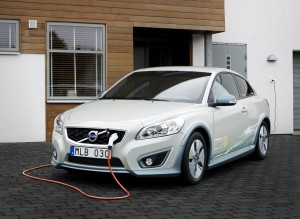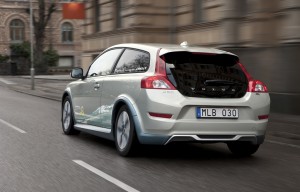
Volvo's battery-electric C30 will begin fleet testing this year, but no date has been set for retail sales.
At first glance, you might not pay much attention to the seemingly familiar Volvo C30 as it rolls by. But the unexpected absence of sound should be a clue that something is not quite as familiar as it first might seem.
That’s because the Swedish import’s conventional gasoline engine has been replaced by a small electric drivetrain. The C30 battery-electric vehicle, or BEV, is, for now, just one of a small fleet of prototypes, but if the until now secret development program pans out, it could bring Volvo’s entry into the small but fast-growing battery commuter car segment.
“The Volvo C30 is the first model we will try out with electric power,” explains Lennart Stegland, Director of Volvo Cars Special Vehicles. “This car’s excellent properties in city traffic and its relatively low weight make it particularly suitable, since electric cars are primarily expected to be used in and around cities and for daily commuting,”
While the automaker isn’t revealing all the details, yet, it appears the C30 BEV will use about 24 kWh of lithium-ion batteries, enough to give it a range of about 150 kilometers, or 94 miles, per charge. The relatively light and compact C30 should be able to accelerate from 0 to 100 kmh (0 to 62.5 mph) in “less than 11 seconds,” according to a corporate news release. Top speed is limited to 130 kmh (about 81 mph).

With 24 kWh of lithium batteries, Volvo estimates a range of 150 km (about 94 miles) with the C30 electric.
Using a 16-amp, 230-volt charging system – the norm in Europe – Volvo says the C30’s batteries will take about 8 hours to recharge. The car appears to be targeted primarily at the Continental market, but for American drivers, it would thus require a high-voltage charger to keep recharging times down to an acceptable level.
In typical Volvo fashion, the automaker has fretted over the potential safety issues related to using high-electric power. That means more than just burying the batteries where they’d be least likely to be damaged during a crash, the automaker notes. There are also challenges to ensuring a safe charge. And there’s also the need to prevent shocks after an accident.
The C30 battery car has undergone a series of internal tests, Volvo reveals, and it appears the maker is going public with the program just as it gets ready to put some of the BEVs out on the street for more extensive validation tests. There’s no clear target date for launching retail sales.
If anything, the automaker notes, “Volvo Cars’ main electrification track over the coming decades is plug-in hybrids,” the automaker says, especially when it comes to larger, heavier vehicles, that would require significantly more lithium-ion cells to work on battery power alone. Volvo plans to bring its first hybrid-electric model to market in 2012.
The company contends that the 150 km range of the C30 BEV would be more than enough for 90% of Europe’s commuters. But there are other issues to consider.
“The consumer must feel that this type of car is attractive both to drive and own. In order to ensure this, we feel that electric cars will have to be as comfortable and safe and offer similar levels of performance as cars with other power sources,” says Paul Gustavsson, Director of Electrification Strategy at Volvo Cars.
“The learning from the C30 BEV project,” he adds, “will help us to fulfill all these criteria and showcase Volvo’s determination to drive developments in the field of electrification.”
